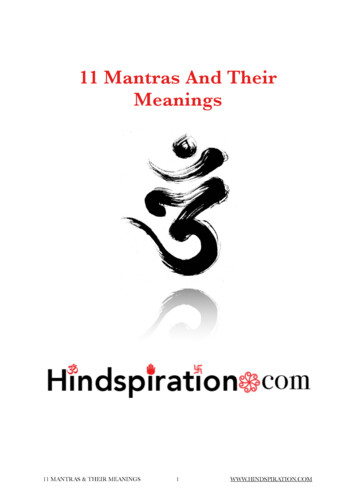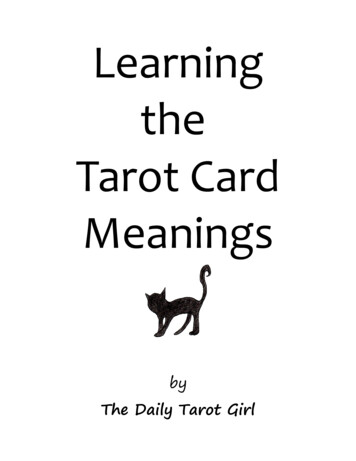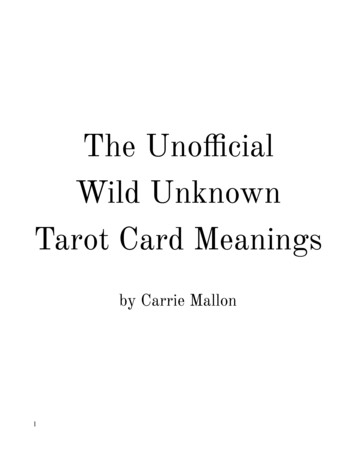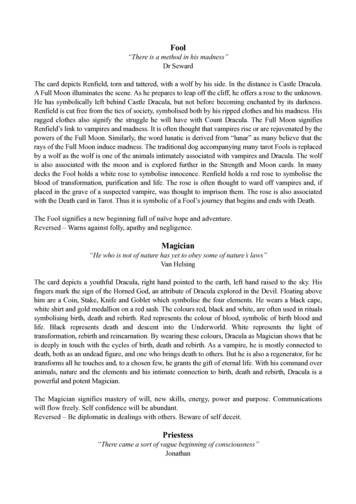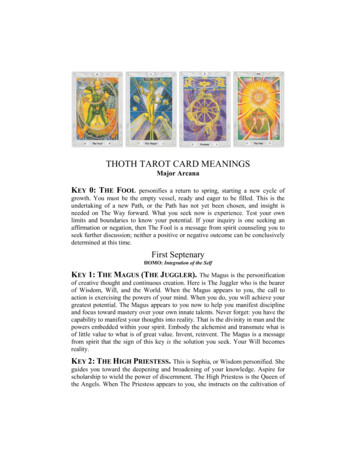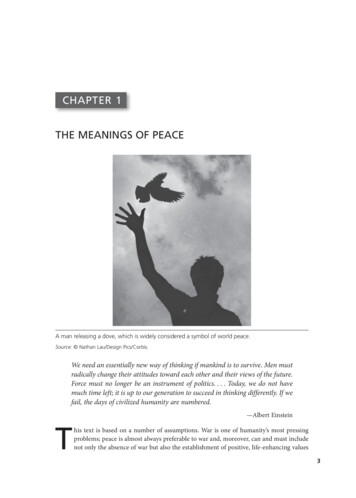
Transcription
CHAPTER 1THE MEANINGS OF PEACEA man releasing a dove, which is widely considered a symbol of world peace.Source: Nathan Lau/Design Pics/Corbis.We need an essentially new way of thinking if mankind is to survive. Men mustradically change their attitudes toward each other and their views of the future.Force must no longer be an instrument of politics. . . . Today, we do not havemuch time left; it is up to our generation to succeed in thinking differently. If wefail, the days of civilized humanity are numbered.—Albert EinsteinThis text is based on a number of assumptions. War is one of humanity’s most pressingproblems; peace is almost always preferable to war and, moreover, can and must includenot only the absence of war but also the establishment of positive, life-enhancing values3
4 PART I: THE PROMISE OF PEACE, THE PROBLEMS OF WARand social structures. We also assume, with regret, that there are no simple solutions to theproblems of war. Most aspects of the war-peace dilemma are complex, interconnected, and, evenwhen well understood, difficult to move from theory to practice. On the other hand, much canbe gained by exploring the various dimensions of war and peace, including the possibility ofachieving a more just and sustainable world—a way of living that can nurture life itself and ofwhich all people can be proud.Throughout this book, we maintain that there is good reason for such hope, not simply as anarticle of faith but based on the realistic premise that human beings are capable of understandingthe global situation and of recognizing their own species-wide best interests. Humans can behaverationally, creatively, and with compassion. Positive steps can be taken that will diminish ourspecies’ reliance on violence in attempting to settle disputes and that will facilitate the development of a more just, sustainable, and truly peaceful world.Most people think they know what peace means, but in fact different people often have verydifferent understandings of this seemingly simple word. And although most would agree thatsome form of peace—whatever it means—is desirable, there are often vigorous, even violent,disagreements over how to obtain it.The Meanings of PeacePeace, like many theoretical terms, is difficult to define. Like happiness, harmony, justice, andfreedom, peace is something we often recognize by its absence. Consequently, Johan Galtung, afounder of peace studies and peace research, has proposed the important distinction between“positive” and “negative” peace. “Positive” peace denotes the simultaneous presence of manydesirable states of mind and society, such as harmony, justice, equity, and so on. “Negative” peacehas historically denoted the “absence of war” and other forms of large-scale violent human conflict.Many philosophical, religious, and cultural traditions have referred to peace in its positivesense. In Chinese, for example, the word heping denotes world peace, or peace among nations,while the words an and mingsi denote an “inner peace,” a tranquil and harmonious state of mindand being, akin to a meditative mental state. Other languages also frame peace in its “inner” and“outer” dimensions.The English lexicon is quite rich in its supply of terms that refer to peace. In Webster’s ThirdNew International Dictionary, for example, peace is initially defined as “freedom from civilclamor and confusion” and positively as “a state of public quiet.”1 This denotes negative andpositive peace in their political or “outer” sense. Webster’s proceeds further to define (political orouter) peace positively as “a state of security or order within a community provided for by law,custom, or public opinion.”The second definition of peace, according to Webster’s, is a “mental or spiritual conditionmarked by freedom from disquieting or oppressive thoughts or emotions.” This is peace in itspersonal or “inner” sense, “peace of mind,” as well as “calmness of mind and heart: serenity ofspirit” (inner peace). Third, peace is defined as “a tranquil state of freedom from outside disturbances and harassment.” Peace also implies “harmony in human or personal relations: mutualconcord and esteem.” This is what we might call interpersonal or intersubjective peace.Peace is then defined by Webster’s as “a state of mutual concord between governments: absenceof hostilities or war.” This is the conventional meaning of peace, as “negative” peace, caused by“the period of such freedom from war.” The sixth definition of peace is the “absence of activity
Chapter 1: The Meanings of Peace 5and noise: deep stillness: quietness,” or what may be called positive inner peace. And in its seventhand final lexicographical meaning, peace is personified as “one that makes, gives, or maintainstranquility.” This is what might be called divine or perpetual peace, with God as the ultimate causeof peace on Earth.In some cases, the word peace even has an undesirable connotation. The Roman poet Tacitusspoke of making a desert and calling it “peace,” an unwanted place of sterility and emptiness.Similarly, although nearly everyone seeks “peace of mind” or “inner peace,” the undesired“peace” of a coma or even of death may not seem so desirable. To be pacified (derived from theLatin word for peace, pax) often means to be lulled into a false and misleading quietude. Indeed,appeasement—buying off a would-be aggressor—has a very bad name indeed. In the most notorious example, British prime minister Neville Chamberlain appeased Hitler in September 1938,famously declaring as he signed the Munich Agreement, which essentially gave in to all ofHitler’s demands: “I believe it is peace for our time.” (Less than a year later, Hitler invadedPoland, effectively starting World War II on the European continent.) By contrast, even the mostpeace-loving among us recognize the merits of certain martial and aggressive attitudes, acts, andmetaphors, especially when they refer to something other than direct military engagements:President Lyndon Johnson’s “war on poverty,” for example, or the medical “war on cancer” and“battle against AIDS.”Some Eastern Concepts of PeaceThe foregoing is not simply a matter of playing with words. Fighting, striving, and engagingin various forms of conflict and combat (especially when they are successful) are widely associated with vigor, energy, courage, and other positive virtues. Nonetheless, it is no exaggeration toclaim that peace may be (with happiness) the most longed-for human condition.Chinese philosopher Lao Tzu (6th century BCE), founder of Taoism and author of the TaoTe Ching, emphasized that military force is not the Tao, or “Way,” for human beings to follow.He frequently referred to peaceful images of water or wind—both of them soft and yielding yetultimately triumphant over such hard substances as rock or iron. The teachings of K’ung fu-tzu(or Confucius, approximately 551–479 BCE) are often thought by most Westerners to revolveexclusively around respect for tradition, including elders and ancestors. But Confucius did nothold to these ideas because he valued obedience and order as virtues in themselves; rather, hemaintained that the attainment of peace was the ultimate human goal and that peace came fromsocial harmony and equilibrium. His best-known collection of writings, the Analects, alsoemphasizes the doctrine of jen (empathy), founded on a kind of hierarchical Golden Rule: Treatyour subordinates as you would like to be treated by your superiors.The writings of another renowned ancient Chinese philosopher and religious leader, Mo Tzu(468–391 BCE), took a more radical perspective. He argued against war and in favor of all-embracing love as a universal human virtue and the highest earthly goal, yet one that is within the graspof each of us. Mo Tzu said, “Those who love others will also be loved in return. Do good to othersand others will do good to you. Hate people and be hated by them. Hurt them and they will hurtyou. What is hard about that?”2 In what is now India, Buddhist monarch Ashoka (3rd centuryBCE) was renowned for abandoning his successful military campaigns in the middle of his careerand devoting himself to the religious conversion of his adversaries by nonviolent means.The great Indian text, the Hindu epic Maha-bha-rata (written about 200 BCE), contains asperhaps its most important segment the Bhagavad Gita. This is a mythic account of a vicious civil
6 PART I: THE PROMISE OF PEACE, THE PROBLEMS OF WARwar in ancient India, in which one of the principal warriors, Arjuna, is reluctant to fight becausemany of his friends and relatives are on the opposing side. Arjuna is ultimately persuaded toengage in combat by the god Krishna, who convinces Arjuna that he must fight, not out of hatredor hope for personal gain but out of selfless duty. Although the Gita can be and has been interpreted as supporting caste loyalty and the obligation to kill when bidden by a superior party todo so, it also inspired the great 20th-century Indian leader Mohandas Gandhi as an allegory forthe de-emphasis of individual self in the pursuit of higher goals. The Gita was also cited by the“father of the atomic bomb,” J. Robert Oppenheimer, when he described the first atomic explosion as a contemporary incarnation of Krishna: “I am become Death, the Destroyer of Worlds.”Some Judeo-Christian Concepts of PeacePeace per se is not prominent in the Old Testament. The God (Yahweh) of Abraham, Moses,and David is frequently portrayed as rather bellicose, even bloodthirsty, and the ancient Israeliteswere often merciless warriors. Exceptions to this norm exist, however, such as the prophet Isaiah,who praised the reign of peace and described war not as a reward or a route to success but ratheras a punishment to be inflicted on those who have failed God.Under the influence of Isaiah and later Hebrew prophets—and despite the ostensibly defensiveviolence of the Maccabees and Zealots (who opposed Roman rule in Palestine and have sometimes been called history’s first recorded terrorists)—Jewish tradition has tended to stronglyendorse peacefulness. On the other hand, it can also be argued that with the emergence of Israelas a militarily threatened—and threatening—state, this tradition has been substantially changed.In fact, Jewish, Christian, and Islamic traditions all have bellicose components and elements intheir history. A key question is whether these militaristic activities—often quite persistent andwidespread—are part of a pattern of faithfulness to, or a deviation from, their underlying religious worldview.A deep irony underlies the concept of peace in these three great Western religious systems.Christianity, for example, gave rise to one of the great warrior traditions in the world, yet it isunique among Western religions in the degree to which it was founded upon a message of peace,love, and nonviolence. “My peace I give unto you,” declares Jesus, according to the NewTestament, along with “the peace of God, which passeth all understanding.” Although definitionsof peace often vary and hypocrisy is not infrequent, most human beings share a positive presumption in favor of peace, in accord with the stated aspirations of these great religions.Positive and Negative PeaceLet us recall the important distinction between positive and negative peace. Negative peaceusually denotes the absence of war. It is a condition in which no active, organized militaryviolence is taking place. When the noted 20th-century French intellectual Raymond Arondefined peace as a condition of “more or less lasting suspension of rivalry between politicalunits,” he was thinking of negative peace.3 Aron’s is the most common understanding of peace inthe context of conventional political science and international relations, and it epitomizes theso-called realist view that peace is found whenever war or other direct forms of organized stateviolence are absent. From this perspective, the peace proclamations of Pharaonic Egypt, thePhilanthropa, were actually statements of negative peace, expressions of benevolence from a
Chapter 1: The Meanings of Peace 7stronger party toward those who were weaker. Similarly, the well-known pax of Roman timesreally indicated little more than the absence of overt organized violence, typically a condition ofnonresistance or even acquiescence enforced by local arrangements and the military might of theRoman legions. The negative peace of the Pax Romana was created and maintained throughsocial and political repression of those who lived under Roman law.An alternative view to this realist (or Realpolitik) perspective is one that emphasizes theimportance of positive peace and that has been particularly advanced by Norwegian peaceresearcher Galtung and others. Positive peace refers to a social condition in which exploitation isminimized or eliminated and in which there is neither overt violence nor the more subtle phenomenon of underlying structural violence. It denotes the continuing presence of an equitableand just social order as well as ecological harmony.Structural and Cultural ViolenceOne commonly understood meaning of violence is that it is physical and readily apparentthrough observable bodily injury and/or the infliction of pain. But it is important to recognizethe existence of other forms of violence, ones that are more indirect and insidious. This structuraland cultural violence is typically built into the very nature of social, cultural, and economic institutions. (For example, both ancient Egypt and imperial Rome practiced slavery and were highlydespotic, although they were technically in states of negative peace for long periods of time.)Structural violence usually has the effect of denying people important rights, such as economic well-being; social, political, and sexual equality; a sense of personal fulfillment and selfworth; and so on. When people starve to death or even go hungry, a kind of violence is takingplace. Similarly, when people suffer f
Chapter 1: The Meanings of Peace 5 and noise: deep stillness: quietness,” or what may be called positive inner peace. And in its seventh and final lexicographical meaning, peace is personified as “one that makes, gives, or maintains tranquility.” This is what might be called divine or perpetual peace, with God as the ultimate cause

